Computerised Accounting in an ERP System
VerifiedAdded on 2023/06/04
|15
|4119
|414
AI Summary
This report provides an overview of SAP S/4HANA Finance, including its historical background, differences between SAP S/4HANA Finance and SAP ERP FICO, and benefits for businesses. It also includes case studies of Fujitsu and Wipro. The report highlights the simplification, increased performance, and ease of use of SAP S/4HANA Finance.
Contribute Materials
Your contribution can guide someone’s learning journey. Share your
documents today.
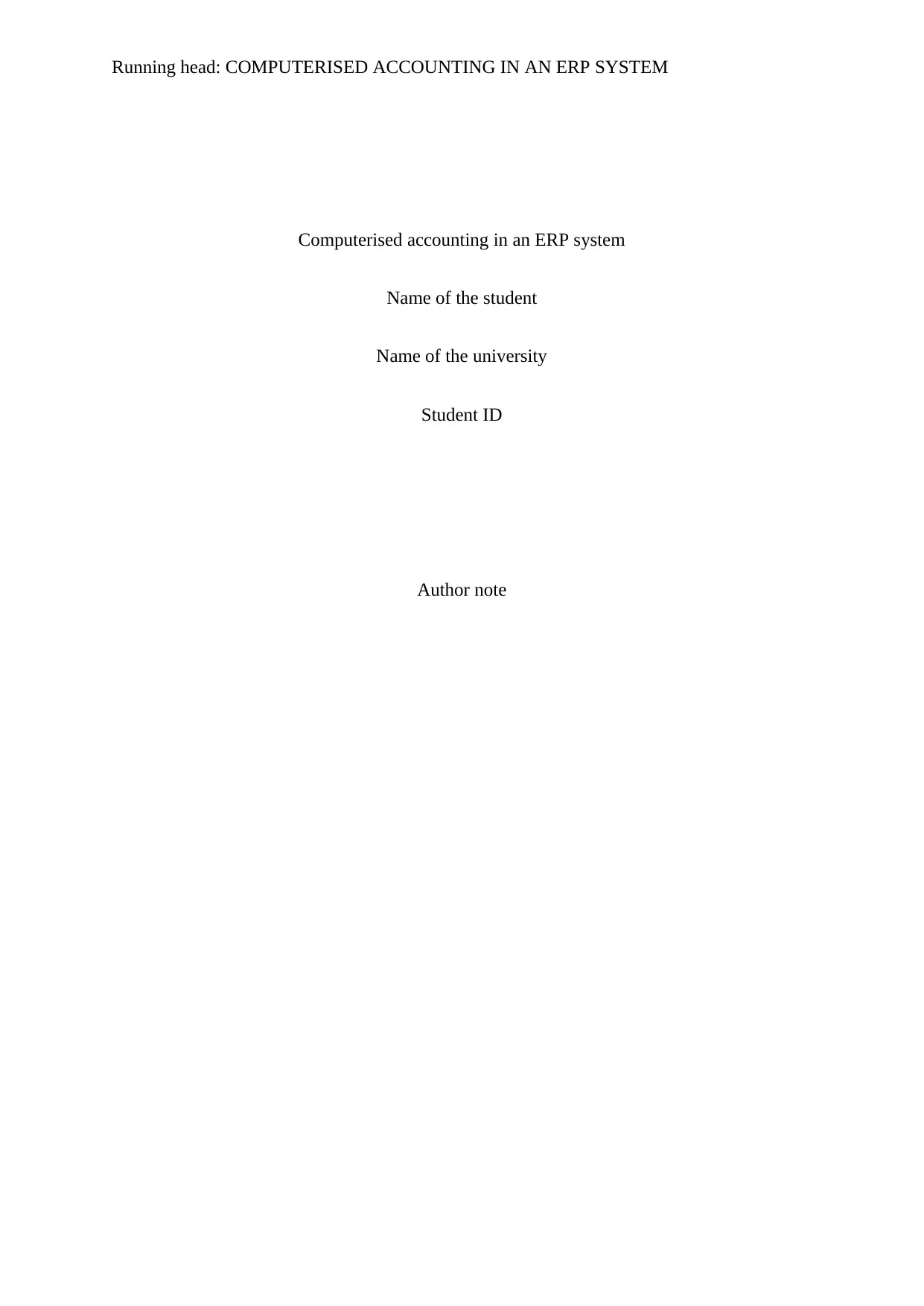
Running head: COMPUTERISED ACCOUNTING IN AN ERP SYSTEM
Computerised accounting in an ERP system
Name of the student
Name of the university
Student ID
Author note
Computerised accounting in an ERP system
Name of the student
Name of the university
Student ID
Author note
Secure Best Marks with AI Grader
Need help grading? Try our AI Grader for instant feedback on your assignments.
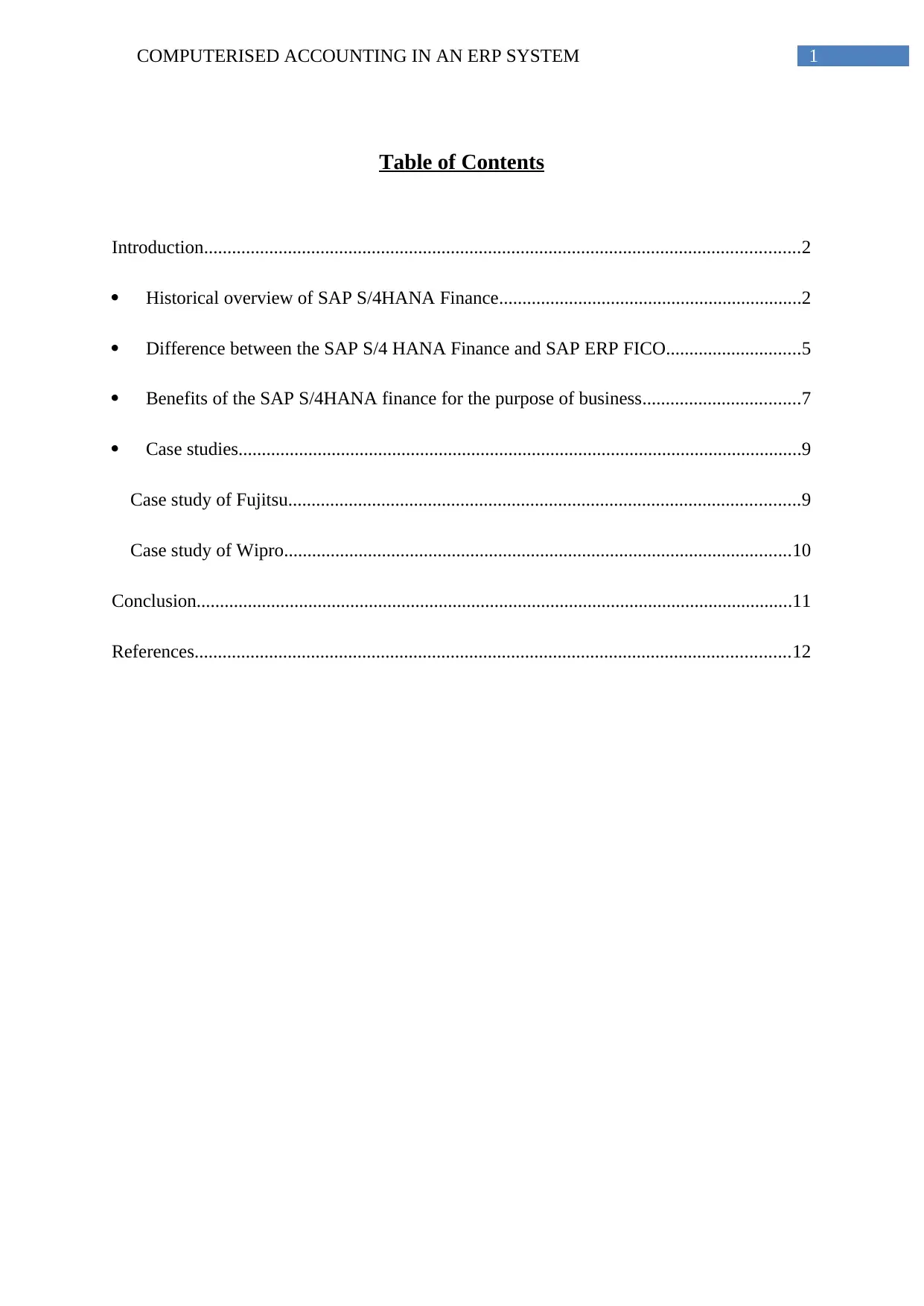
1COMPUTERISED ACCOUNTING IN AN ERP SYSTEM
Table of Contents
Introduction................................................................................................................................2
Historical overview of SAP S/4HANA Finance.................................................................2
Difference between the SAP S/4 HANA Finance and SAP ERP FICO.............................5
Benefits of the SAP S/4HANA finance for the purpose of business..................................7
Case studies.........................................................................................................................9
Case study of Fujitsu..............................................................................................................9
Case study of Wipro.............................................................................................................10
Conclusion................................................................................................................................11
References................................................................................................................................12
Table of Contents
Introduction................................................................................................................................2
Historical overview of SAP S/4HANA Finance.................................................................2
Difference between the SAP S/4 HANA Finance and SAP ERP FICO.............................5
Benefits of the SAP S/4HANA finance for the purpose of business..................................7
Case studies.........................................................................................................................9
Case study of Fujitsu..............................................................................................................9
Case study of Wipro.............................................................................................................10
Conclusion................................................................................................................................11
References................................................................................................................................12
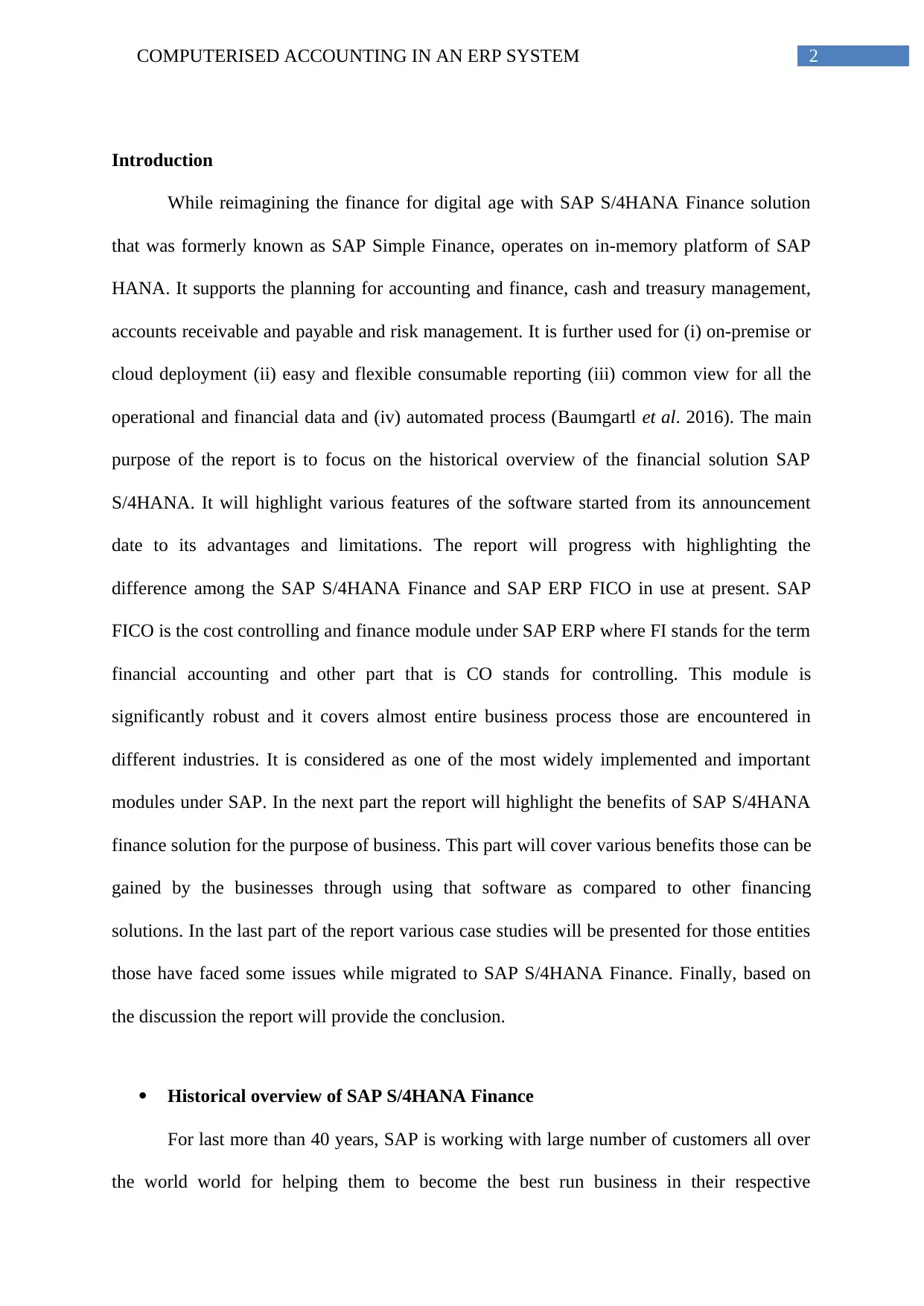
2COMPUTERISED ACCOUNTING IN AN ERP SYSTEM
Introduction
While reimagining the finance for digital age with SAP S/4HANA Finance solution
that was formerly known as SAP Simple Finance, operates on in-memory platform of SAP
HANA. It supports the planning for accounting and finance, cash and treasury management,
accounts receivable and payable and risk management. It is further used for (i) on-premise or
cloud deployment (ii) easy and flexible consumable reporting (iii) common view for all the
operational and financial data and (iv) automated process (Baumgartl et al. 2016). The main
purpose of the report is to focus on the historical overview of the financial solution SAP
S/4HANA. It will highlight various features of the software started from its announcement
date to its advantages and limitations. The report will progress with highlighting the
difference among the SAP S/4HANA Finance and SAP ERP FICO in use at present. SAP
FICO is the cost controlling and finance module under SAP ERP where FI stands for the term
financial accounting and other part that is CO stands for controlling. This module is
significantly robust and it covers almost entire business process those are encountered in
different industries. It is considered as one of the most widely implemented and important
modules under SAP. In the next part the report will highlight the benefits of SAP S/4HANA
finance solution for the purpose of business. This part will cover various benefits those can be
gained by the businesses through using that software as compared to other financing
solutions. In the last part of the report various case studies will be presented for those entities
those have faced some issues while migrated to SAP S/4HANA Finance. Finally, based on
the discussion the report will provide the conclusion.
Historical overview of SAP S/4HANA Finance
For last more than 40 years, SAP is working with large number of customers all over
the world world for helping them to become the best run business in their respective
Introduction
While reimagining the finance for digital age with SAP S/4HANA Finance solution
that was formerly known as SAP Simple Finance, operates on in-memory platform of SAP
HANA. It supports the planning for accounting and finance, cash and treasury management,
accounts receivable and payable and risk management. It is further used for (i) on-premise or
cloud deployment (ii) easy and flexible consumable reporting (iii) common view for all the
operational and financial data and (iv) automated process (Baumgartl et al. 2016). The main
purpose of the report is to focus on the historical overview of the financial solution SAP
S/4HANA. It will highlight various features of the software started from its announcement
date to its advantages and limitations. The report will progress with highlighting the
difference among the SAP S/4HANA Finance and SAP ERP FICO in use at present. SAP
FICO is the cost controlling and finance module under SAP ERP where FI stands for the term
financial accounting and other part that is CO stands for controlling. This module is
significantly robust and it covers almost entire business process those are encountered in
different industries. It is considered as one of the most widely implemented and important
modules under SAP. In the next part the report will highlight the benefits of SAP S/4HANA
finance solution for the purpose of business. This part will cover various benefits those can be
gained by the businesses through using that software as compared to other financing
solutions. In the last part of the report various case studies will be presented for those entities
those have faced some issues while migrated to SAP S/4HANA Finance. Finally, based on
the discussion the report will provide the conclusion.
Historical overview of SAP S/4HANA Finance
For last more than 40 years, SAP is working with large number of customers all over
the world world for helping them to become the best run business in their respective
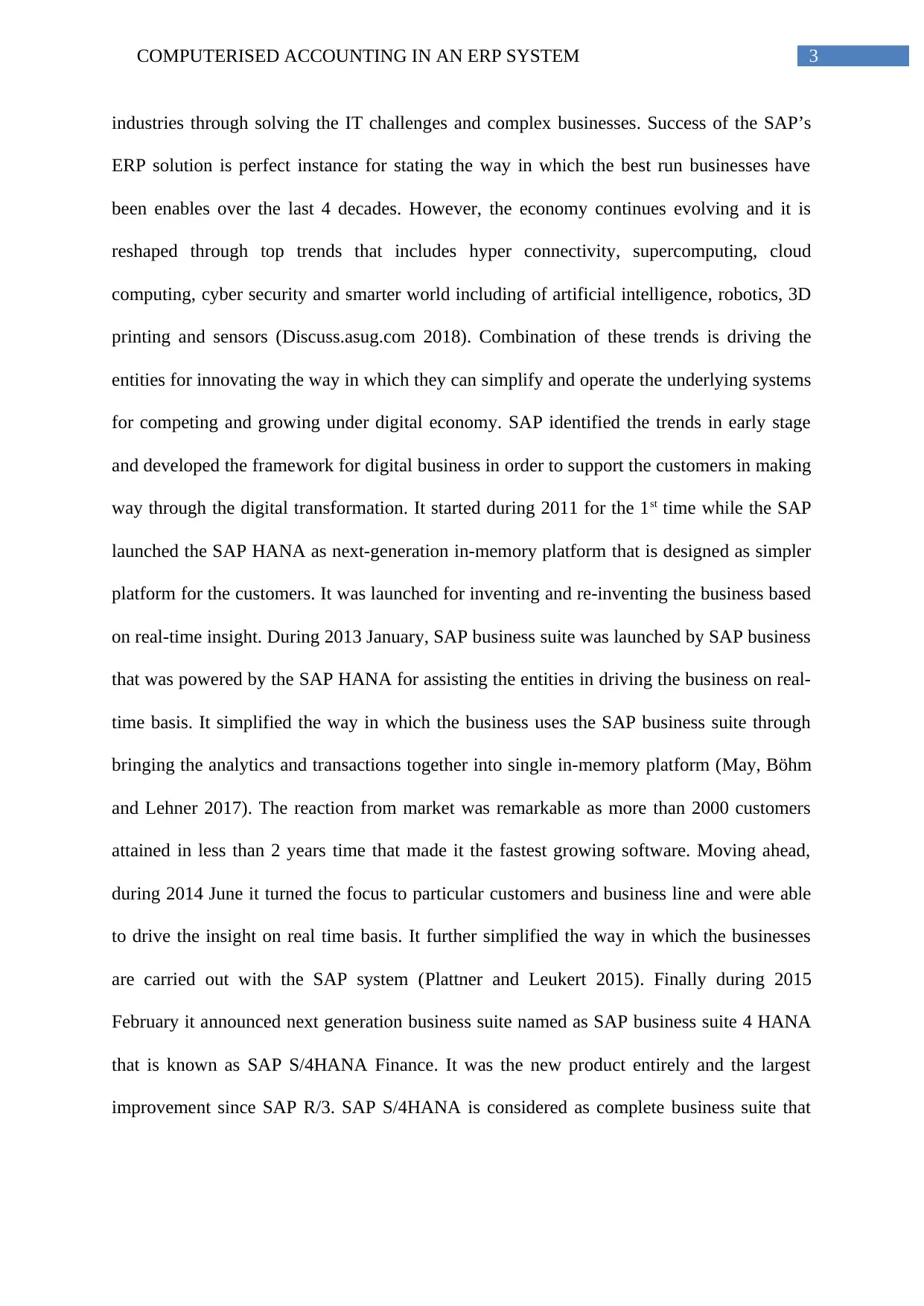
3COMPUTERISED ACCOUNTING IN AN ERP SYSTEM
industries through solving the IT challenges and complex businesses. Success of the SAP’s
ERP solution is perfect instance for stating the way in which the best run businesses have
been enables over the last 4 decades. However, the economy continues evolving and it is
reshaped through top trends that includes hyper connectivity, supercomputing, cloud
computing, cyber security and smarter world including of artificial intelligence, robotics, 3D
printing and sensors (Discuss.asug.com 2018). Combination of these trends is driving the
entities for innovating the way in which they can simplify and operate the underlying systems
for competing and growing under digital economy. SAP identified the trends in early stage
and developed the framework for digital business in order to support the customers in making
way through the digital transformation. It started during 2011 for the 1st time while the SAP
launched the SAP HANA as next-generation in-memory platform that is designed as simpler
platform for the customers. It was launched for inventing and re-inventing the business based
on real-time insight. During 2013 January, SAP business suite was launched by SAP business
that was powered by the SAP HANA for assisting the entities in driving the business on real-
time basis. It simplified the way in which the business uses the SAP business suite through
bringing the analytics and transactions together into single in-memory platform (May, Böhm
and Lehner 2017). The reaction from market was remarkable as more than 2000 customers
attained in less than 2 years time that made it the fastest growing software. Moving ahead,
during 2014 June it turned the focus to particular customers and business line and were able
to drive the insight on real time basis. It further simplified the way in which the businesses
are carried out with the SAP system (Plattner and Leukert 2015). Finally during 2015
February it announced next generation business suite named as SAP business suite 4 HANA
that is known as SAP S/4HANA Finance. It was the new product entirely and the largest
improvement since SAP R/3. SAP S/4HANA is considered as complete business suite that
industries through solving the IT challenges and complex businesses. Success of the SAP’s
ERP solution is perfect instance for stating the way in which the best run businesses have
been enables over the last 4 decades. However, the economy continues evolving and it is
reshaped through top trends that includes hyper connectivity, supercomputing, cloud
computing, cyber security and smarter world including of artificial intelligence, robotics, 3D
printing and sensors (Discuss.asug.com 2018). Combination of these trends is driving the
entities for innovating the way in which they can simplify and operate the underlying systems
for competing and growing under digital economy. SAP identified the trends in early stage
and developed the framework for digital business in order to support the customers in making
way through the digital transformation. It started during 2011 for the 1st time while the SAP
launched the SAP HANA as next-generation in-memory platform that is designed as simpler
platform for the customers. It was launched for inventing and re-inventing the business based
on real-time insight. During 2013 January, SAP business suite was launched by SAP business
that was powered by the SAP HANA for assisting the entities in driving the business on real-
time basis. It simplified the way in which the business uses the SAP business suite through
bringing the analytics and transactions together into single in-memory platform (May, Böhm
and Lehner 2017). The reaction from market was remarkable as more than 2000 customers
attained in less than 2 years time that made it the fastest growing software. Moving ahead,
during 2014 June it turned the focus to particular customers and business line and were able
to drive the insight on real time basis. It further simplified the way in which the businesses
are carried out with the SAP system (Plattner and Leukert 2015). Finally during 2015
February it announced next generation business suite named as SAP business suite 4 HANA
that is known as SAP S/4HANA Finance. It was the new product entirely and the largest
improvement since SAP R/3. SAP S/4HANA is considered as complete business suite that
Secure Best Marks with AI Grader
Need help grading? Try our AI Grader for instant feedback on your assignments.
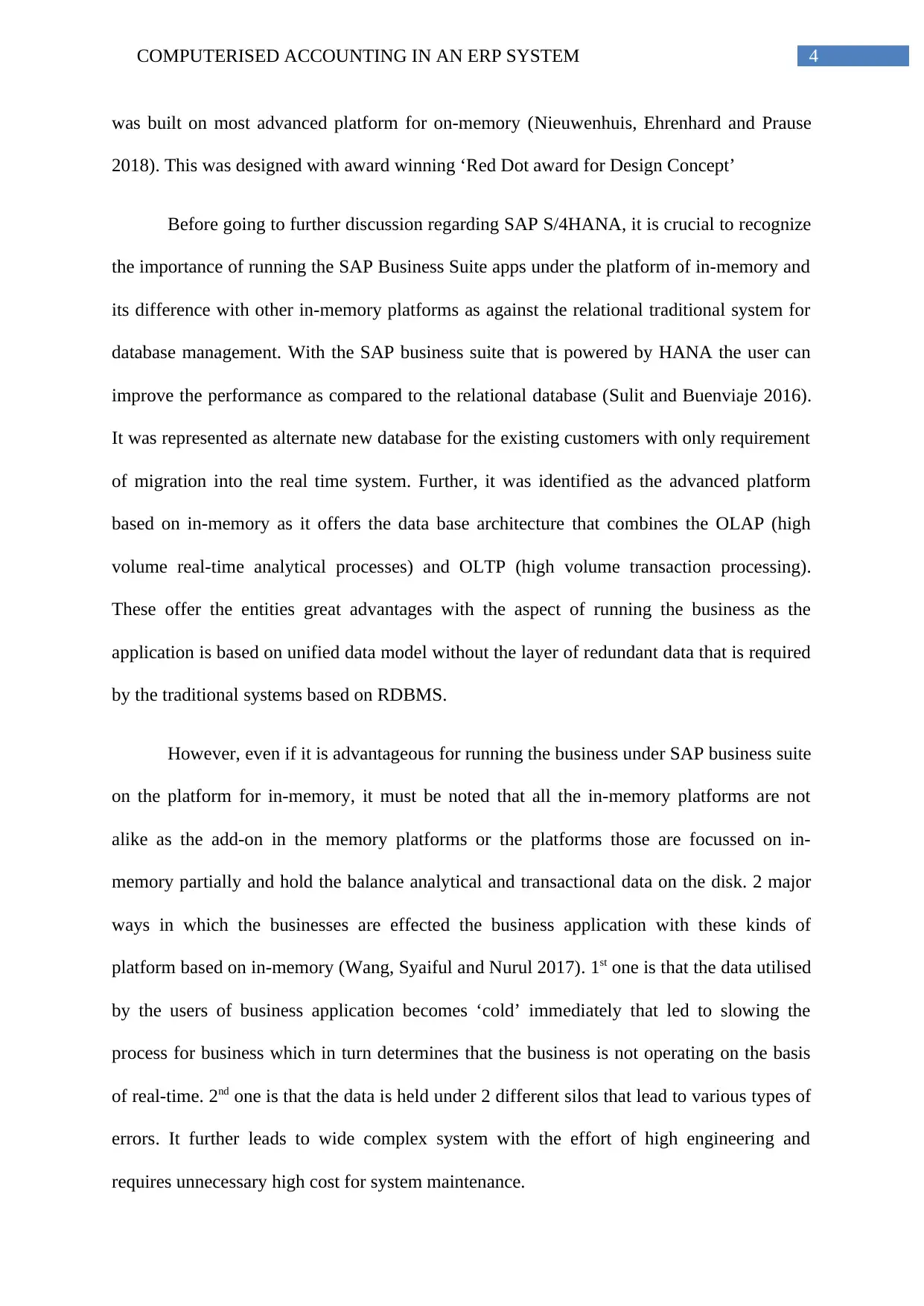
4COMPUTERISED ACCOUNTING IN AN ERP SYSTEM
was built on most advanced platform for on-memory (Nieuwenhuis, Ehrenhard and Prause
2018). This was designed with award winning ‘Red Dot award for Design Concept’
Before going to further discussion regarding SAP S/4HANA, it is crucial to recognize
the importance of running the SAP Business Suite apps under the platform of in-memory and
its difference with other in-memory platforms as against the relational traditional system for
database management. With the SAP business suite that is powered by HANA the user can
improve the performance as compared to the relational database (Sulit and Buenviaje 2016).
It was represented as alternate new database for the existing customers with only requirement
of migration into the real time system. Further, it was identified as the advanced platform
based on in-memory as it offers the data base architecture that combines the OLAP (high
volume real-time analytical processes) and OLTP (high volume transaction processing).
These offer the entities great advantages with the aspect of running the business as the
application is based on unified data model without the layer of redundant data that is required
by the traditional systems based on RDBMS.
However, even if it is advantageous for running the business under SAP business suite
on the platform for in-memory, it must be noted that all the in-memory platforms are not
alike as the add-on in the memory platforms or the platforms those are focussed on in-
memory partially and hold the balance analytical and transactional data on the disk. 2 major
ways in which the businesses are effected the business application with these kinds of
platform based on in-memory (Wang, Syaiful and Nurul 2017). 1st one is that the data utilised
by the users of business application becomes ‘cold’ immediately that led to slowing the
process for business which in turn determines that the business is not operating on the basis
of real-time. 2nd one is that the data is held under 2 different silos that lead to various types of
errors. It further leads to wide complex system with the effort of high engineering and
requires unnecessary high cost for system maintenance.
was built on most advanced platform for on-memory (Nieuwenhuis, Ehrenhard and Prause
2018). This was designed with award winning ‘Red Dot award for Design Concept’
Before going to further discussion regarding SAP S/4HANA, it is crucial to recognize
the importance of running the SAP Business Suite apps under the platform of in-memory and
its difference with other in-memory platforms as against the relational traditional system for
database management. With the SAP business suite that is powered by HANA the user can
improve the performance as compared to the relational database (Sulit and Buenviaje 2016).
It was represented as alternate new database for the existing customers with only requirement
of migration into the real time system. Further, it was identified as the advanced platform
based on in-memory as it offers the data base architecture that combines the OLAP (high
volume real-time analytical processes) and OLTP (high volume transaction processing).
These offer the entities great advantages with the aspect of running the business as the
application is based on unified data model without the layer of redundant data that is required
by the traditional systems based on RDBMS.
However, even if it is advantageous for running the business under SAP business suite
on the platform for in-memory, it must be noted that all the in-memory platforms are not
alike as the add-on in the memory platforms or the platforms those are focussed on in-
memory partially and hold the balance analytical and transactional data on the disk. 2 major
ways in which the businesses are effected the business application with these kinds of
platform based on in-memory (Wang, Syaiful and Nurul 2017). 1st one is that the data utilised
by the users of business application becomes ‘cold’ immediately that led to slowing the
process for business which in turn determines that the business is not operating on the basis
of real-time. 2nd one is that the data is held under 2 different silos that lead to various types of
errors. It further leads to wide complex system with the effort of high engineering and
requires unnecessary high cost for system maintenance.
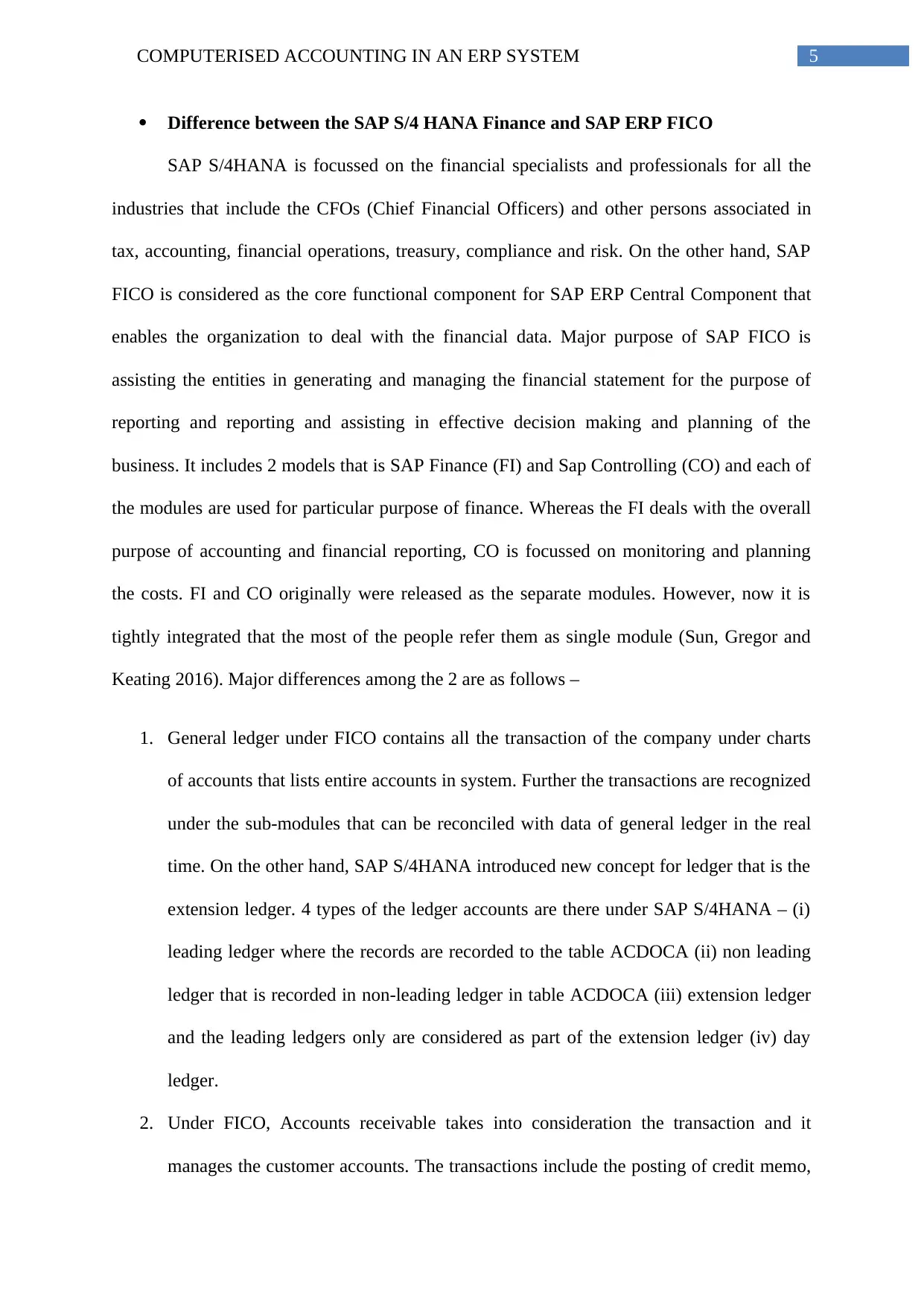
5COMPUTERISED ACCOUNTING IN AN ERP SYSTEM
Difference between the SAP S/4 HANA Finance and SAP ERP FICO
SAP S/4HANA is focussed on the financial specialists and professionals for all the
industries that include the CFOs (Chief Financial Officers) and other persons associated in
tax, accounting, financial operations, treasury, compliance and risk. On the other hand, SAP
FICO is considered as the core functional component for SAP ERP Central Component that
enables the organization to deal with the financial data. Major purpose of SAP FICO is
assisting the entities in generating and managing the financial statement for the purpose of
reporting and reporting and assisting in effective decision making and planning of the
business. It includes 2 models that is SAP Finance (FI) and Sap Controlling (CO) and each of
the modules are used for particular purpose of finance. Whereas the FI deals with the overall
purpose of accounting and financial reporting, CO is focussed on monitoring and planning
the costs. FI and CO originally were released as the separate modules. However, now it is
tightly integrated that the most of the people refer them as single module (Sun, Gregor and
Keating 2016). Major differences among the 2 are as follows –
1. General ledger under FICO contains all the transaction of the company under charts
of accounts that lists entire accounts in system. Further the transactions are recognized
under the sub-modules that can be reconciled with data of general ledger in the real
time. On the other hand, SAP S/4HANA introduced new concept for ledger that is the
extension ledger. 4 types of the ledger accounts are there under SAP S/4HANA – (i)
leading ledger where the records are recorded to the table ACDOCA (ii) non leading
ledger that is recorded in non-leading ledger in table ACDOCA (iii) extension ledger
and the leading ledgers only are considered as part of the extension ledger (iv) day
ledger.
2. Under FICO, Accounts receivable takes into consideration the transaction and it
manages the customer accounts. The transactions include the posting of credit memo,
Difference between the SAP S/4 HANA Finance and SAP ERP FICO
SAP S/4HANA is focussed on the financial specialists and professionals for all the
industries that include the CFOs (Chief Financial Officers) and other persons associated in
tax, accounting, financial operations, treasury, compliance and risk. On the other hand, SAP
FICO is considered as the core functional component for SAP ERP Central Component that
enables the organization to deal with the financial data. Major purpose of SAP FICO is
assisting the entities in generating and managing the financial statement for the purpose of
reporting and reporting and assisting in effective decision making and planning of the
business. It includes 2 models that is SAP Finance (FI) and Sap Controlling (CO) and each of
the modules are used for particular purpose of finance. Whereas the FI deals with the overall
purpose of accounting and financial reporting, CO is focussed on monitoring and planning
the costs. FI and CO originally were released as the separate modules. However, now it is
tightly integrated that the most of the people refer them as single module (Sun, Gregor and
Keating 2016). Major differences among the 2 are as follows –
1. General ledger under FICO contains all the transaction of the company under charts
of accounts that lists entire accounts in system. Further the transactions are recognized
under the sub-modules that can be reconciled with data of general ledger in the real
time. On the other hand, SAP S/4HANA introduced new concept for ledger that is the
extension ledger. 4 types of the ledger accounts are there under SAP S/4HANA – (i)
leading ledger where the records are recorded to the table ACDOCA (ii) non leading
ledger that is recorded in non-leading ledger in table ACDOCA (iii) extension ledger
and the leading ledgers only are considered as part of the extension ledger (iv) day
ledger.
2. Under FICO, Accounts receivable takes into consideration the transaction and it
manages the customer accounts. The transactions include the posting of credit memo,

6COMPUTERISED ACCOUNTING IN AN ERP SYSTEM
posting of invoice, down payments, dunning, executing the reports of the customers
and payment of invoices. On the other hand, under SAP S/4HANA, it boosts the
payment and cash flow visibility, improve the relationship with vendors, cut costs,
payment and pricing through obtaining the tighter control over the process of invoice
management. Further, through monitoring the payments and receivables in the real
time. This software assists in responding rapidly under the fluctuating market
conditions, identifying the risks involved in accounts and improving the financial
health.
3. Under FICO, Asset accounting controls all transactions associated with the fixed asset
of the entity like heavy equipment, buildings and land. The transactions include
acquisition of asset, sales, retirement, revaluations, transfer, sales and depreciation.
Under SAP S/4HANA different accounting principles are controlled through setting
up various areas for depreciation. new asset accounting is the area where the app
further optimized for running with the additional functionality and under new
structure for data with full integration and the ACDOCA table.
4. Under FICO, Accounts payable includes all the transactions associated to vendors and
it further manages all the vendor accounts. Transaction involves posting of credit
memo, posting of invoice, down payments, dunning, executing the reports of the
customers and executing the vendor reports. On the other hand, SAP S/4HANA
improves the accuracy and sped for the accounts payable and receivable procedure
with SAP. It uses latest technologies for assessing the credit risk of the customer on
quick basis. It further simplifies the system of billing, maximises the visibility and
improves the management of invoices.
5. Under FICO, Bank ledger manages all the bank accounts data and transaction of the
entity. It further can reconcile the transactions recorded under the bank statement and
posting of invoice, down payments, dunning, executing the reports of the customers
and payment of invoices. On the other hand, under SAP S/4HANA, it boosts the
payment and cash flow visibility, improve the relationship with vendors, cut costs,
payment and pricing through obtaining the tighter control over the process of invoice
management. Further, through monitoring the payments and receivables in the real
time. This software assists in responding rapidly under the fluctuating market
conditions, identifying the risks involved in accounts and improving the financial
health.
3. Under FICO, Asset accounting controls all transactions associated with the fixed asset
of the entity like heavy equipment, buildings and land. The transactions include
acquisition of asset, sales, retirement, revaluations, transfer, sales and depreciation.
Under SAP S/4HANA different accounting principles are controlled through setting
up various areas for depreciation. new asset accounting is the area where the app
further optimized for running with the additional functionality and under new
structure for data with full integration and the ACDOCA table.
4. Under FICO, Accounts payable includes all the transactions associated to vendors and
it further manages all the vendor accounts. Transaction involves posting of credit
memo, posting of invoice, down payments, dunning, executing the reports of the
customers and executing the vendor reports. On the other hand, SAP S/4HANA
improves the accuracy and sped for the accounts payable and receivable procedure
with SAP. It uses latest technologies for assessing the credit risk of the customer on
quick basis. It further simplifies the system of billing, maximises the visibility and
improves the management of invoices.
5. Under FICO, Bank ledger manages all the bank accounts data and transaction of the
entity. It further can reconcile the transactions recorded under the bank statement and
Paraphrase This Document
Need a fresh take? Get an instant paraphrase of this document with our AI Paraphraser
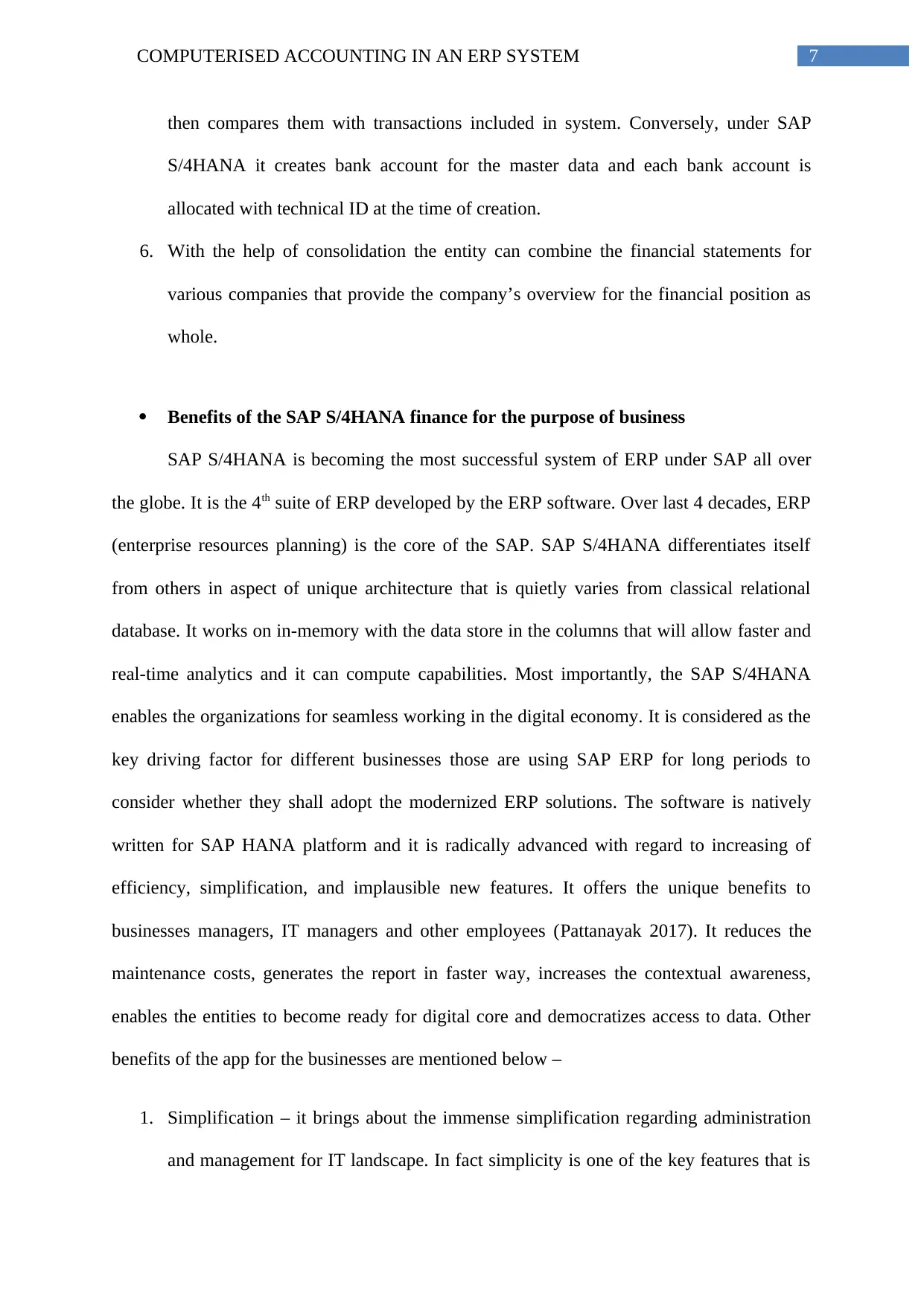
7COMPUTERISED ACCOUNTING IN AN ERP SYSTEM
then compares them with transactions included in system. Conversely, under SAP
S/4HANA it creates bank account for the master data and each bank account is
allocated with technical ID at the time of creation.
6. With the help of consolidation the entity can combine the financial statements for
various companies that provide the company’s overview for the financial position as
whole.
Benefits of the SAP S/4HANA finance for the purpose of business
SAP S/4HANA is becoming the most successful system of ERP under SAP all over
the globe. It is the 4th suite of ERP developed by the ERP software. Over last 4 decades, ERP
(enterprise resources planning) is the core of the SAP. SAP S/4HANA differentiates itself
from others in aspect of unique architecture that is quietly varies from classical relational
database. It works on in-memory with the data store in the columns that will allow faster and
real-time analytics and it can compute capabilities. Most importantly, the SAP S/4HANA
enables the organizations for seamless working in the digital economy. It is considered as the
key driving factor for different businesses those are using SAP ERP for long periods to
consider whether they shall adopt the modernized ERP solutions. The software is natively
written for SAP HANA platform and it is radically advanced with regard to increasing of
efficiency, simplification, and implausible new features. It offers the unique benefits to
businesses managers, IT managers and other employees (Pattanayak 2017). It reduces the
maintenance costs, generates the report in faster way, increases the contextual awareness,
enables the entities to become ready for digital core and democratizes access to data. Other
benefits of the app for the businesses are mentioned below –
1. Simplification – it brings about the immense simplification regarding administration
and management for IT landscape. In fact simplicity is one of the key features that is
then compares them with transactions included in system. Conversely, under SAP
S/4HANA it creates bank account for the master data and each bank account is
allocated with technical ID at the time of creation.
6. With the help of consolidation the entity can combine the financial statements for
various companies that provide the company’s overview for the financial position as
whole.
Benefits of the SAP S/4HANA finance for the purpose of business
SAP S/4HANA is becoming the most successful system of ERP under SAP all over
the globe. It is the 4th suite of ERP developed by the ERP software. Over last 4 decades, ERP
(enterprise resources planning) is the core of the SAP. SAP S/4HANA differentiates itself
from others in aspect of unique architecture that is quietly varies from classical relational
database. It works on in-memory with the data store in the columns that will allow faster and
real-time analytics and it can compute capabilities. Most importantly, the SAP S/4HANA
enables the organizations for seamless working in the digital economy. It is considered as the
key driving factor for different businesses those are using SAP ERP for long periods to
consider whether they shall adopt the modernized ERP solutions. The software is natively
written for SAP HANA platform and it is radically advanced with regard to increasing of
efficiency, simplification, and implausible new features. It offers the unique benefits to
businesses managers, IT managers and other employees (Pattanayak 2017). It reduces the
maintenance costs, generates the report in faster way, increases the contextual awareness,
enables the entities to become ready for digital core and democratizes access to data. Other
benefits of the app for the businesses are mentioned below –
1. Simplification – it brings about the immense simplification regarding administration
and management for IT landscape. In fact simplicity is one of the key features that is

8COMPUTERISED ACCOUNTING IN AN ERP SYSTEM
brought by the ECC application structure. It further enables centralizing of the
network and hardware resources and it serves as digital core for the simplification of
business procedure through deploying the power of in-memory database. In past
times, the enterprise often ran for the issues associated with multiple batch run.
Exclusion of the aggregate tables, reduction of the processing time and easiness with
which the systems can reciprocate to the queries and transactions, assures that the
users will be able to spend the efforts towards strategic growth
2. Increased performance – it improves the performance through allowing the users to
execute, plan, generating reports, analysing the data and triggering the closing periods
and providing the improved predictions. It further enables the company in providing
better services for the customer centric apps. HANA provides increased awareness
and access to democratized data (Okungbowa 2015).
3. Easy in using – Fiori 2.0 offers modern design for completely new experience to the
users that enables them to access the overview pages, list reports and work lists easily.
SAP Fiori’s UI is specifically designed to become highly intuitive, responsive,
personalized and simple that allows the users to question promptly and access the
required details irrespective of the deployment or device. It enables the entity to
evolve and drive additional revenues eventually. It further connects with the
customers at deeper level, access big data; obtain relevant insights in real time which
in turn will support in faster decision making (Okungbowa 2015).
4. Innovation - SAP S/4HANA sets stage for the purpose of future innovation.
Technology is rapidly evolving that means just keeping up will not cut it any further.
Enterprises required staying ahead of curve and taking the future ready decisions. The
application leverages the speed, data accessibility and context. It further adopted the
cloud through business that is the platform that enables the organizations in delivering
brought by the ECC application structure. It further enables centralizing of the
network and hardware resources and it serves as digital core for the simplification of
business procedure through deploying the power of in-memory database. In past
times, the enterprise often ran for the issues associated with multiple batch run.
Exclusion of the aggregate tables, reduction of the processing time and easiness with
which the systems can reciprocate to the queries and transactions, assures that the
users will be able to spend the efforts towards strategic growth
2. Increased performance – it improves the performance through allowing the users to
execute, plan, generating reports, analysing the data and triggering the closing periods
and providing the improved predictions. It further enables the company in providing
better services for the customer centric apps. HANA provides increased awareness
and access to democratized data (Okungbowa 2015).
3. Easy in using – Fiori 2.0 offers modern design for completely new experience to the
users that enables them to access the overview pages, list reports and work lists easily.
SAP Fiori’s UI is specifically designed to become highly intuitive, responsive,
personalized and simple that allows the users to question promptly and access the
required details irrespective of the deployment or device. It enables the entity to
evolve and drive additional revenues eventually. It further connects with the
customers at deeper level, access big data; obtain relevant insights in real time which
in turn will support in faster decision making (Okungbowa 2015).
4. Innovation - SAP S/4HANA sets stage for the purpose of future innovation.
Technology is rapidly evolving that means just keeping up will not cut it any further.
Enterprises required staying ahead of curve and taking the future ready decisions. The
application leverages the speed, data accessibility and context. It further adopted the
cloud through business that is the platform that enables the organizations in delivering
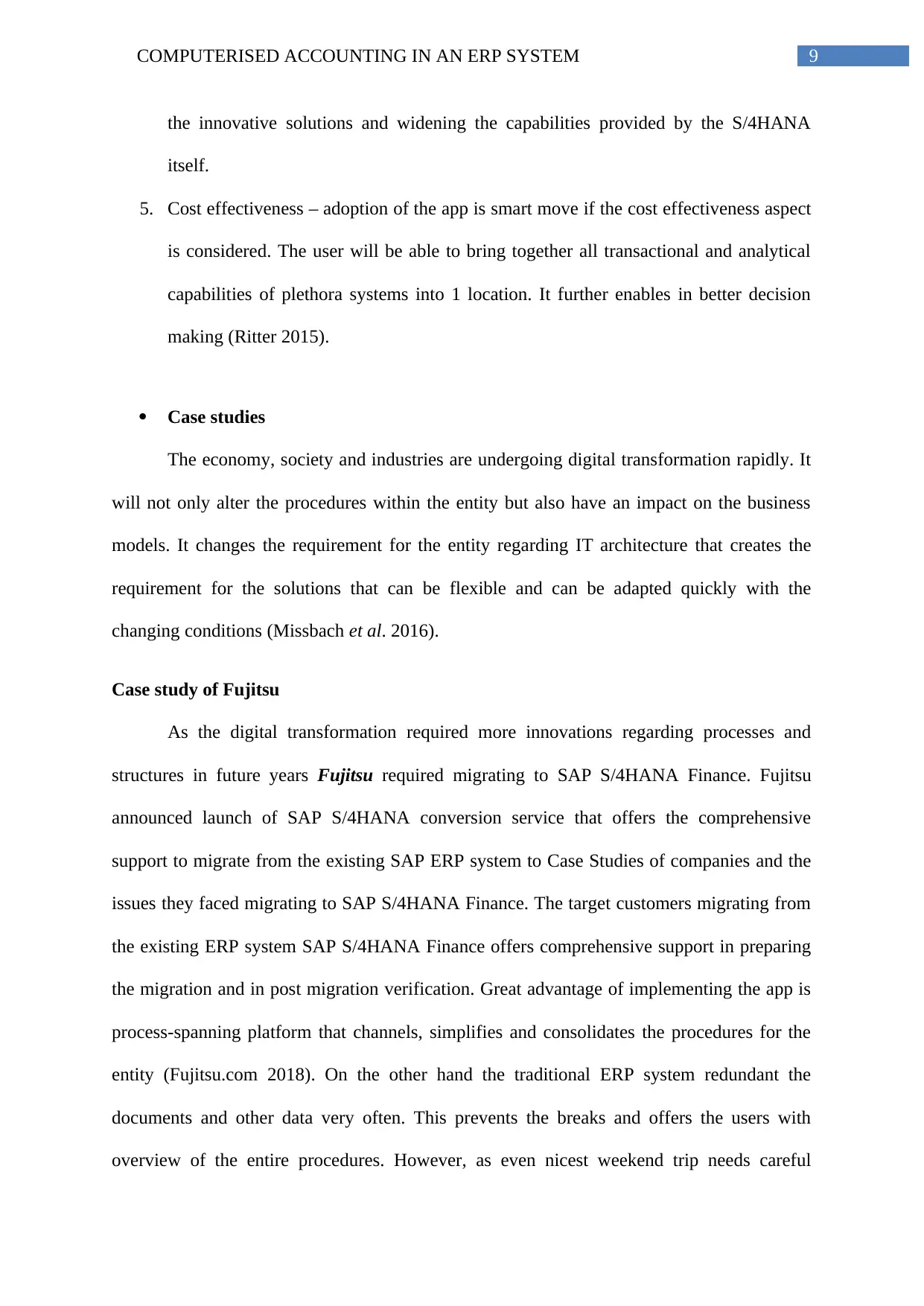
9COMPUTERISED ACCOUNTING IN AN ERP SYSTEM
the innovative solutions and widening the capabilities provided by the S/4HANA
itself.
5. Cost effectiveness – adoption of the app is smart move if the cost effectiveness aspect
is considered. The user will be able to bring together all transactional and analytical
capabilities of plethora systems into 1 location. It further enables in better decision
making (Ritter 2015).
Case studies
The economy, society and industries are undergoing digital transformation rapidly. It
will not only alter the procedures within the entity but also have an impact on the business
models. It changes the requirement for the entity regarding IT architecture that creates the
requirement for the solutions that can be flexible and can be adapted quickly with the
changing conditions (Missbach et al. 2016).
Case study of Fujitsu
As the digital transformation required more innovations regarding processes and
structures in future years Fujitsu required migrating to SAP S/4HANA Finance. Fujitsu
announced launch of SAP S/4HANA conversion service that offers the comprehensive
support to migrate from the existing SAP ERP system to Case Studies of companies and the
issues they faced migrating to SAP S/4HANA Finance. The target customers migrating from
the existing ERP system SAP S/4HANA Finance offers comprehensive support in preparing
the migration and in post migration verification. Great advantage of implementing the app is
process-spanning platform that channels, simplifies and consolidates the procedures for the
entity (Fujitsu.com 2018). On the other hand the traditional ERP system redundant the
documents and other data very often. This prevents the breaks and offers the users with
overview of the entire procedures. However, as even nicest weekend trip needs careful
the innovative solutions and widening the capabilities provided by the S/4HANA
itself.
5. Cost effectiveness – adoption of the app is smart move if the cost effectiveness aspect
is considered. The user will be able to bring together all transactional and analytical
capabilities of plethora systems into 1 location. It further enables in better decision
making (Ritter 2015).
Case studies
The economy, society and industries are undergoing digital transformation rapidly. It
will not only alter the procedures within the entity but also have an impact on the business
models. It changes the requirement for the entity regarding IT architecture that creates the
requirement for the solutions that can be flexible and can be adapted quickly with the
changing conditions (Missbach et al. 2016).
Case study of Fujitsu
As the digital transformation required more innovations regarding processes and
structures in future years Fujitsu required migrating to SAP S/4HANA Finance. Fujitsu
announced launch of SAP S/4HANA conversion service that offers the comprehensive
support to migrate from the existing SAP ERP system to Case Studies of companies and the
issues they faced migrating to SAP S/4HANA Finance. The target customers migrating from
the existing ERP system SAP S/4HANA Finance offers comprehensive support in preparing
the migration and in post migration verification. Great advantage of implementing the app is
process-spanning platform that channels, simplifies and consolidates the procedures for the
entity (Fujitsu.com 2018). On the other hand the traditional ERP system redundant the
documents and other data very often. This prevents the breaks and offers the users with
overview of the entire procedures. However, as even nicest weekend trip needs careful
Secure Best Marks with AI Grader
Need help grading? Try our AI Grader for instant feedback on your assignments.
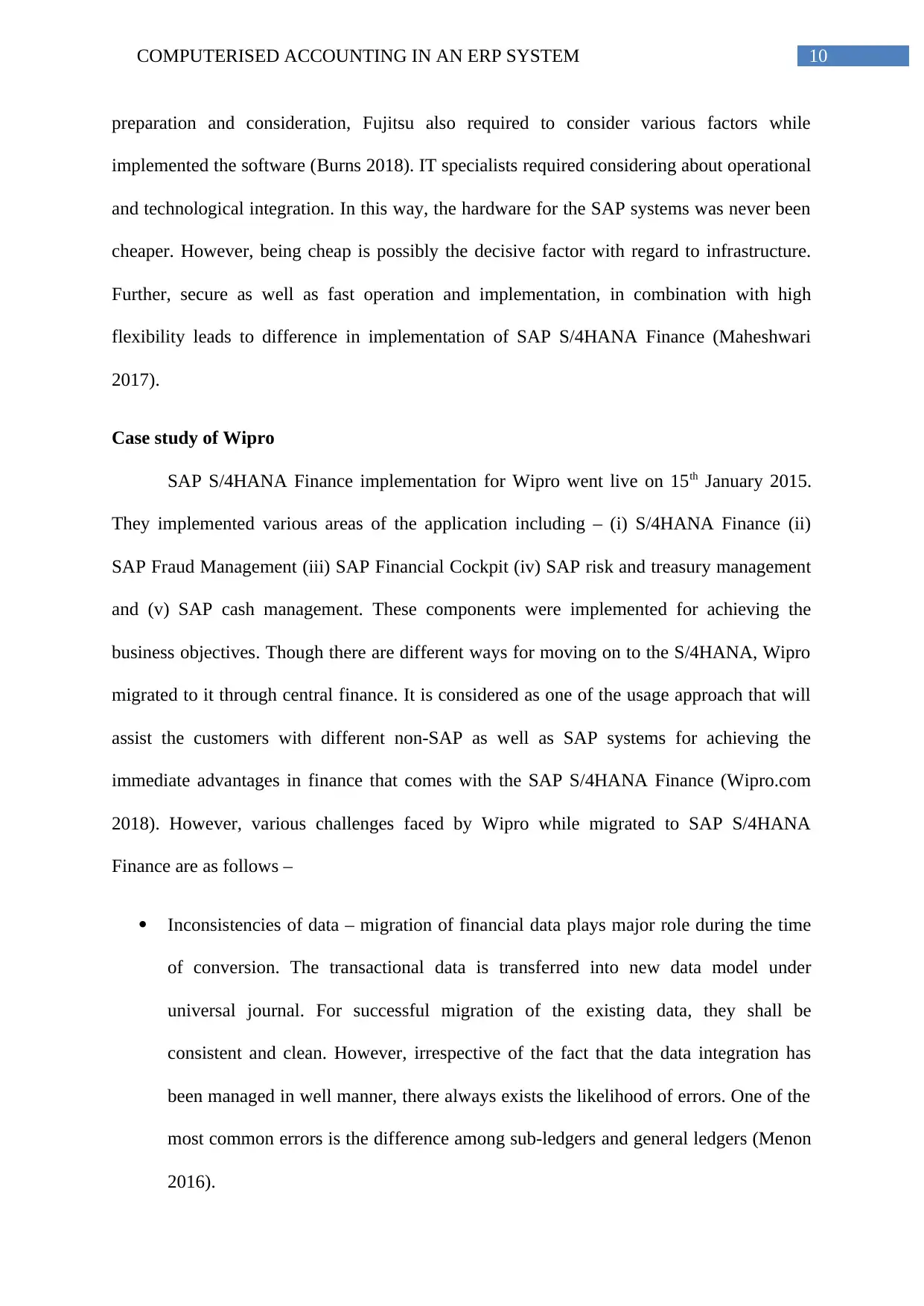
10COMPUTERISED ACCOUNTING IN AN ERP SYSTEM
preparation and consideration, Fujitsu also required to consider various factors while
implemented the software (Burns 2018). IT specialists required considering about operational
and technological integration. In this way, the hardware for the SAP systems was never been
cheaper. However, being cheap is possibly the decisive factor with regard to infrastructure.
Further, secure as well as fast operation and implementation, in combination with high
flexibility leads to difference in implementation of SAP S/4HANA Finance (Maheshwari
2017).
Case study of Wipro
SAP S/4HANA Finance implementation for Wipro went live on 15th January 2015.
They implemented various areas of the application including – (i) S/4HANA Finance (ii)
SAP Fraud Management (iii) SAP Financial Cockpit (iv) SAP risk and treasury management
and (v) SAP cash management. These components were implemented for achieving the
business objectives. Though there are different ways for moving on to the S/4HANA, Wipro
migrated to it through central finance. It is considered as one of the usage approach that will
assist the customers with different non-SAP as well as SAP systems for achieving the
immediate advantages in finance that comes with the SAP S/4HANA Finance (Wipro.com
2018). However, various challenges faced by Wipro while migrated to SAP S/4HANA
Finance are as follows –
Inconsistencies of data – migration of financial data plays major role during the time
of conversion. The transactional data is transferred into new data model under
universal journal. For successful migration of the existing data, they shall be
consistent and clean. However, irrespective of the fact that the data integration has
been managed in well manner, there always exists the likelihood of errors. One of the
most common errors is the difference among sub-ledgers and general ledgers (Menon
2016).
preparation and consideration, Fujitsu also required to consider various factors while
implemented the software (Burns 2018). IT specialists required considering about operational
and technological integration. In this way, the hardware for the SAP systems was never been
cheaper. However, being cheap is possibly the decisive factor with regard to infrastructure.
Further, secure as well as fast operation and implementation, in combination with high
flexibility leads to difference in implementation of SAP S/4HANA Finance (Maheshwari
2017).
Case study of Wipro
SAP S/4HANA Finance implementation for Wipro went live on 15th January 2015.
They implemented various areas of the application including – (i) S/4HANA Finance (ii)
SAP Fraud Management (iii) SAP Financial Cockpit (iv) SAP risk and treasury management
and (v) SAP cash management. These components were implemented for achieving the
business objectives. Though there are different ways for moving on to the S/4HANA, Wipro
migrated to it through central finance. It is considered as one of the usage approach that will
assist the customers with different non-SAP as well as SAP systems for achieving the
immediate advantages in finance that comes with the SAP S/4HANA Finance (Wipro.com
2018). However, various challenges faced by Wipro while migrated to SAP S/4HANA
Finance are as follows –
Inconsistencies of data – migration of financial data plays major role during the time
of conversion. The transactional data is transferred into new data model under
universal journal. For successful migration of the existing data, they shall be
consistent and clean. However, irrespective of the fact that the data integration has
been managed in well manner, there always exists the likelihood of errors. One of the
most common errors is the difference among sub-ledgers and general ledgers (Menon
2016).
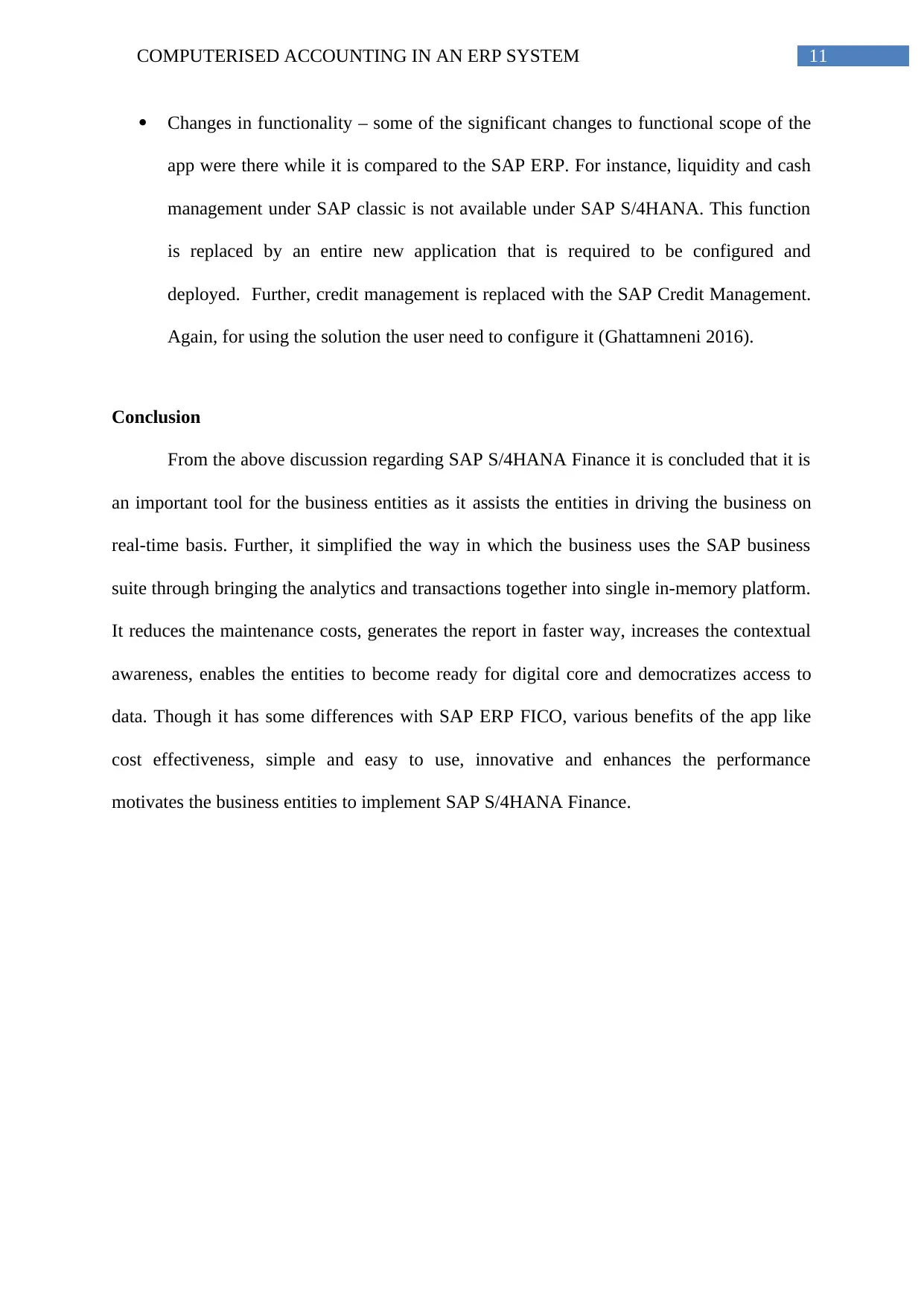
11COMPUTERISED ACCOUNTING IN AN ERP SYSTEM
Changes in functionality – some of the significant changes to functional scope of the
app were there while it is compared to the SAP ERP. For instance, liquidity and cash
management under SAP classic is not available under SAP S/4HANA. This function
is replaced by an entire new application that is required to be configured and
deployed. Further, credit management is replaced with the SAP Credit Management.
Again, for using the solution the user need to configure it (Ghattamneni 2016).
Conclusion
From the above discussion regarding SAP S/4HANA Finance it is concluded that it is
an important tool for the business entities as it assists the entities in driving the business on
real-time basis. Further, it simplified the way in which the business uses the SAP business
suite through bringing the analytics and transactions together into single in-memory platform.
It reduces the maintenance costs, generates the report in faster way, increases the contextual
awareness, enables the entities to become ready for digital core and democratizes access to
data. Though it has some differences with SAP ERP FICO, various benefits of the app like
cost effectiveness, simple and easy to use, innovative and enhances the performance
motivates the business entities to implement SAP S/4HANA Finance.
Changes in functionality – some of the significant changes to functional scope of the
app were there while it is compared to the SAP ERP. For instance, liquidity and cash
management under SAP classic is not available under SAP S/4HANA. This function
is replaced by an entire new application that is required to be configured and
deployed. Further, credit management is replaced with the SAP Credit Management.
Again, for using the solution the user need to configure it (Ghattamneni 2016).
Conclusion
From the above discussion regarding SAP S/4HANA Finance it is concluded that it is
an important tool for the business entities as it assists the entities in driving the business on
real-time basis. Further, it simplified the way in which the business uses the SAP business
suite through bringing the analytics and transactions together into single in-memory platform.
It reduces the maintenance costs, generates the report in faster way, increases the contextual
awareness, enables the entities to become ready for digital core and democratizes access to
data. Though it has some differences with SAP ERP FICO, various benefits of the app like
cost effectiveness, simple and easy to use, innovative and enhances the performance
motivates the business entities to implement SAP S/4HANA Finance.
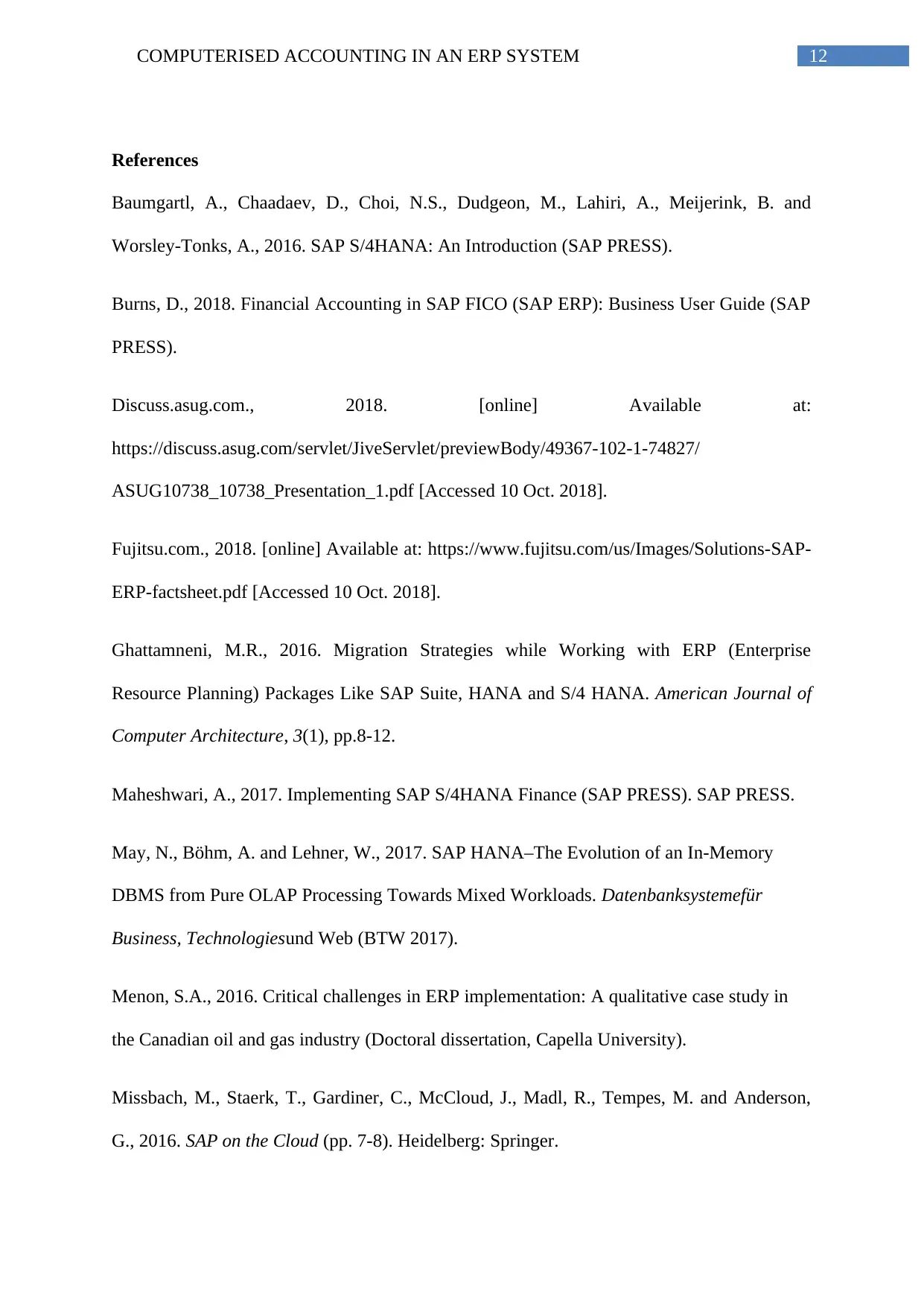
12COMPUTERISED ACCOUNTING IN AN ERP SYSTEM
References
Baumgartl, A., Chaadaev, D., Choi, N.S., Dudgeon, M., Lahiri, A., Meijerink, B. and
Worsley-Tonks, A., 2016. SAP S/4HANA: An Introduction (SAP PRESS).
Burns, D., 2018. Financial Accounting in SAP FICO (SAP ERP): Business User Guide (SAP
PRESS).
Discuss.asug.com., 2018. [online] Available at:
https://discuss.asug.com/servlet/JiveServlet/previewBody/49367-102-1-74827/
ASUG10738_10738_Presentation_1.pdf [Accessed 10 Oct. 2018].
Fujitsu.com., 2018. [online] Available at: https://www.fujitsu.com/us/Images/Solutions-SAP-
ERP-factsheet.pdf [Accessed 10 Oct. 2018].
Ghattamneni, M.R., 2016. Migration Strategies while Working with ERP (Enterprise
Resource Planning) Packages Like SAP Suite, HANA and S/4 HANA. American Journal of
Computer Architecture, 3(1), pp.8-12.
Maheshwari, A., 2017. Implementing SAP S/4HANA Finance (SAP PRESS). SAP PRESS.
May, N., Böhm, A. and Lehner, W., 2017. SAP HANA–The Evolution of an In-Memory
DBMS from Pure OLAP Processing Towards Mixed Workloads. Datenbanksystemefür
Business, Technologiesund Web (BTW 2017).
Menon, S.A., 2016. Critical challenges in ERP implementation: A qualitative case study in
the Canadian oil and gas industry (Doctoral dissertation, Capella University).
Missbach, M., Staerk, T., Gardiner, C., McCloud, J., Madl, R., Tempes, M. and Anderson,
G., 2016. SAP on the Cloud (pp. 7-8). Heidelberg: Springer.
References
Baumgartl, A., Chaadaev, D., Choi, N.S., Dudgeon, M., Lahiri, A., Meijerink, B. and
Worsley-Tonks, A., 2016. SAP S/4HANA: An Introduction (SAP PRESS).
Burns, D., 2018. Financial Accounting in SAP FICO (SAP ERP): Business User Guide (SAP
PRESS).
Discuss.asug.com., 2018. [online] Available at:
https://discuss.asug.com/servlet/JiveServlet/previewBody/49367-102-1-74827/
ASUG10738_10738_Presentation_1.pdf [Accessed 10 Oct. 2018].
Fujitsu.com., 2018. [online] Available at: https://www.fujitsu.com/us/Images/Solutions-SAP-
ERP-factsheet.pdf [Accessed 10 Oct. 2018].
Ghattamneni, M.R., 2016. Migration Strategies while Working with ERP (Enterprise
Resource Planning) Packages Like SAP Suite, HANA and S/4 HANA. American Journal of
Computer Architecture, 3(1), pp.8-12.
Maheshwari, A., 2017. Implementing SAP S/4HANA Finance (SAP PRESS). SAP PRESS.
May, N., Böhm, A. and Lehner, W., 2017. SAP HANA–The Evolution of an In-Memory
DBMS from Pure OLAP Processing Towards Mixed Workloads. Datenbanksystemefür
Business, Technologiesund Web (BTW 2017).
Menon, S.A., 2016. Critical challenges in ERP implementation: A qualitative case study in
the Canadian oil and gas industry (Doctoral dissertation, Capella University).
Missbach, M., Staerk, T., Gardiner, C., McCloud, J., Madl, R., Tempes, M. and Anderson,
G., 2016. SAP on the Cloud (pp. 7-8). Heidelberg: Springer.
Paraphrase This Document
Need a fresh take? Get an instant paraphrase of this document with our AI Paraphraser
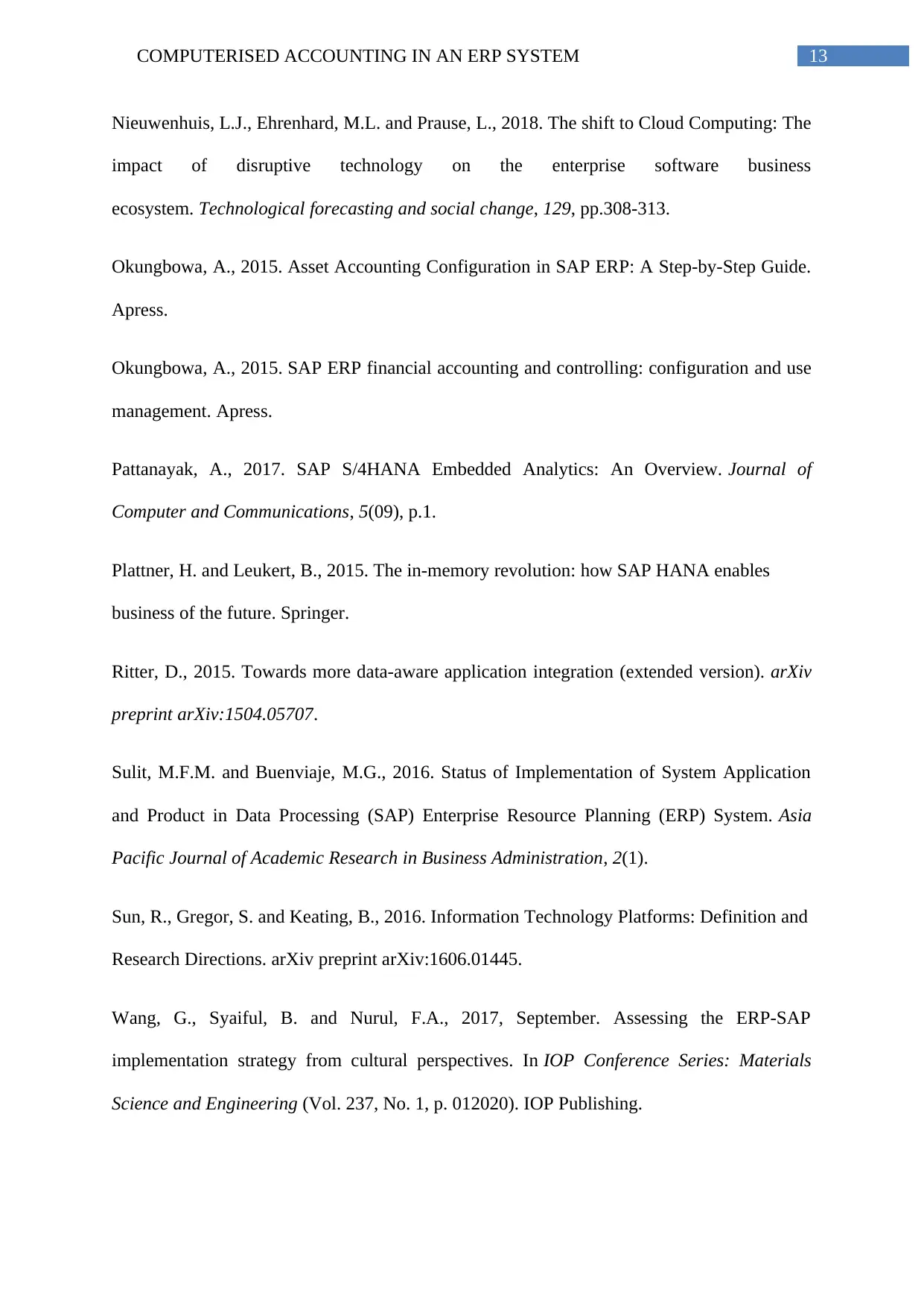
13COMPUTERISED ACCOUNTING IN AN ERP SYSTEM
Nieuwenhuis, L.J., Ehrenhard, M.L. and Prause, L., 2018. The shift to Cloud Computing: The
impact of disruptive technology on the enterprise software business
ecosystem. Technological forecasting and social change, 129, pp.308-313.
Okungbowa, A., 2015. Asset Accounting Configuration in SAP ERP: A Step-by-Step Guide.
Apress.
Okungbowa, A., 2015. SAP ERP financial accounting and controlling: configuration and use
management. Apress.
Pattanayak, A., 2017. SAP S/4HANA Embedded Analytics: An Overview. Journal of
Computer and Communications, 5(09), p.1.
Plattner, H. and Leukert, B., 2015. The in-memory revolution: how SAP HANA enables
business of the future. Springer.
Ritter, D., 2015. Towards more data-aware application integration (extended version). arXiv
preprint arXiv:1504.05707.
Sulit, M.F.M. and Buenviaje, M.G., 2016. Status of Implementation of System Application
and Product in Data Processing (SAP) Enterprise Resource Planning (ERP) System. Asia
Pacific Journal of Academic Research in Business Administration, 2(1).
Sun, R., Gregor, S. and Keating, B., 2016. Information Technology Platforms: Definition and
Research Directions. arXiv preprint arXiv:1606.01445.
Wang, G., Syaiful, B. and Nurul, F.A., 2017, September. Assessing the ERP-SAP
implementation strategy from cultural perspectives. In IOP Conference Series: Materials
Science and Engineering (Vol. 237, No. 1, p. 012020). IOP Publishing.
Nieuwenhuis, L.J., Ehrenhard, M.L. and Prause, L., 2018. The shift to Cloud Computing: The
impact of disruptive technology on the enterprise software business
ecosystem. Technological forecasting and social change, 129, pp.308-313.
Okungbowa, A., 2015. Asset Accounting Configuration in SAP ERP: A Step-by-Step Guide.
Apress.
Okungbowa, A., 2015. SAP ERP financial accounting and controlling: configuration and use
management. Apress.
Pattanayak, A., 2017. SAP S/4HANA Embedded Analytics: An Overview. Journal of
Computer and Communications, 5(09), p.1.
Plattner, H. and Leukert, B., 2015. The in-memory revolution: how SAP HANA enables
business of the future. Springer.
Ritter, D., 2015. Towards more data-aware application integration (extended version). arXiv
preprint arXiv:1504.05707.
Sulit, M.F.M. and Buenviaje, M.G., 2016. Status of Implementation of System Application
and Product in Data Processing (SAP) Enterprise Resource Planning (ERP) System. Asia
Pacific Journal of Academic Research in Business Administration, 2(1).
Sun, R., Gregor, S. and Keating, B., 2016. Information Technology Platforms: Definition and
Research Directions. arXiv preprint arXiv:1606.01445.
Wang, G., Syaiful, B. and Nurul, F.A., 2017, September. Assessing the ERP-SAP
implementation strategy from cultural perspectives. In IOP Conference Series: Materials
Science and Engineering (Vol. 237, No. 1, p. 012020). IOP Publishing.
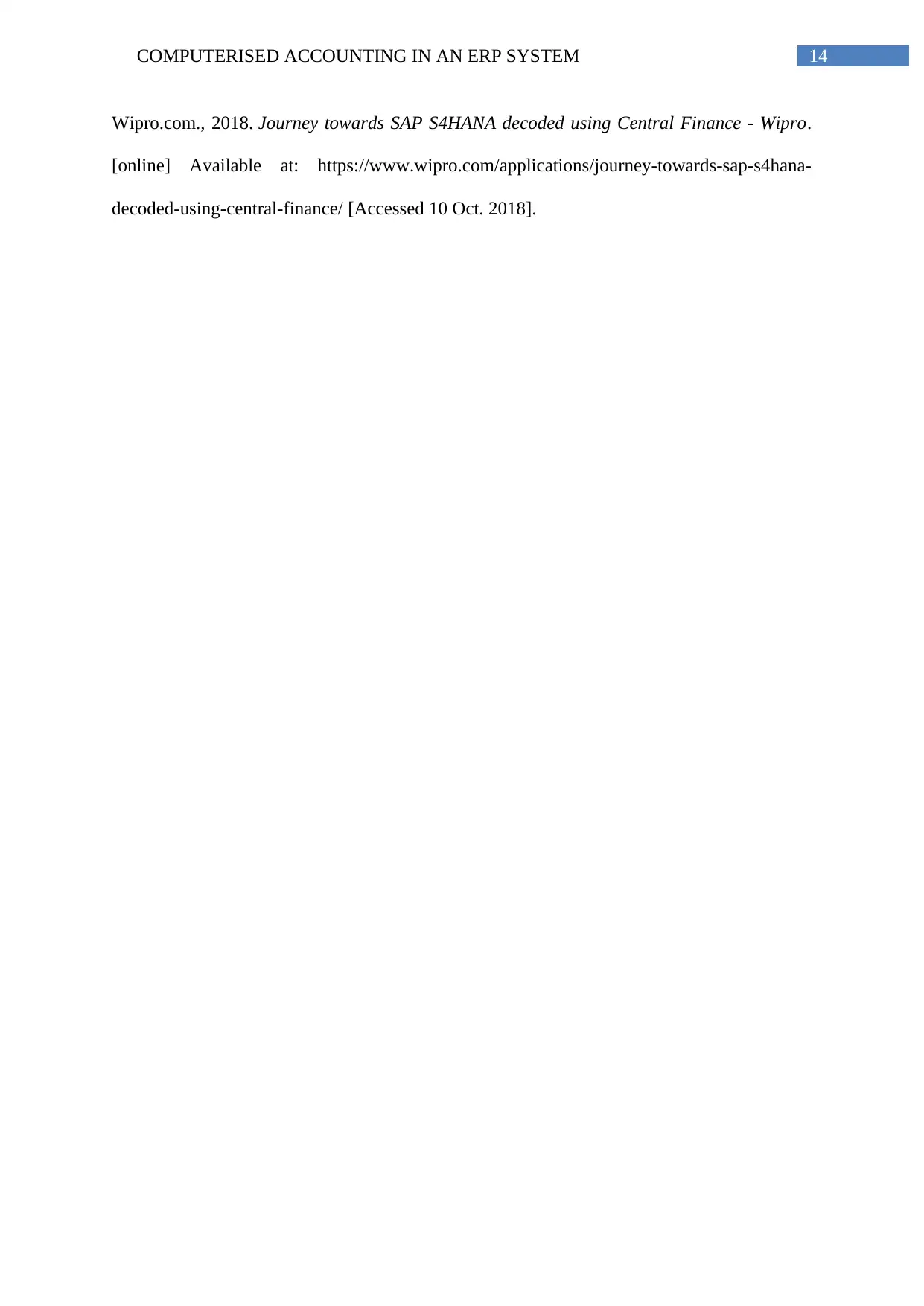
14COMPUTERISED ACCOUNTING IN AN ERP SYSTEM
Wipro.com., 2018. Journey towards SAP S4HANA decoded using Central Finance - Wipro.
[online] Available at: https://www.wipro.com/applications/journey-towards-sap-s4hana-
decoded-using-central-finance/ [Accessed 10 Oct. 2018].
Wipro.com., 2018. Journey towards SAP S4HANA decoded using Central Finance - Wipro.
[online] Available at: https://www.wipro.com/applications/journey-towards-sap-s4hana-
decoded-using-central-finance/ [Accessed 10 Oct. 2018].
1 out of 15
Related Documents
Your All-in-One AI-Powered Toolkit for Academic Success.
+13062052269
info@desklib.com
Available 24*7 on WhatsApp / Email
![[object Object]](/_next/static/media/star-bottom.7253800d.svg)
Unlock your academic potential
© 2024 | Zucol Services PVT LTD | All rights reserved.





